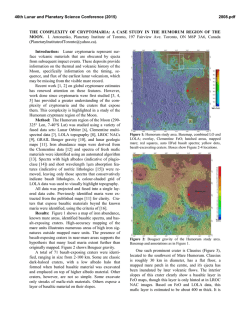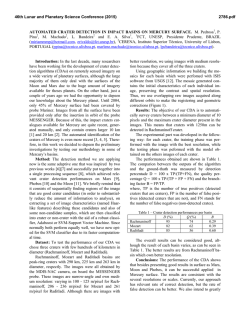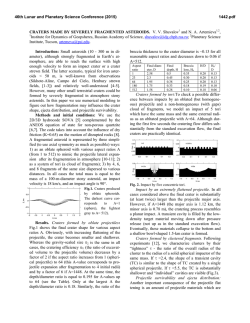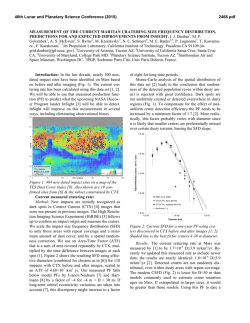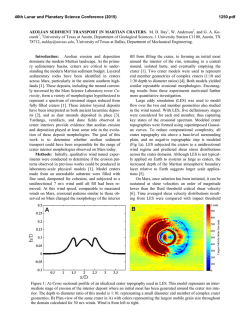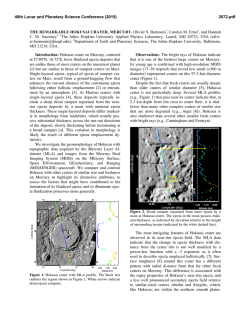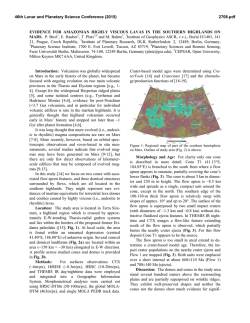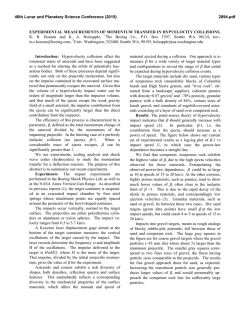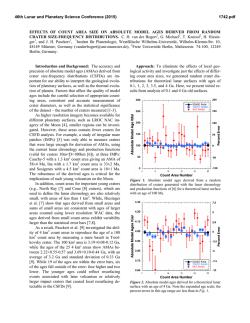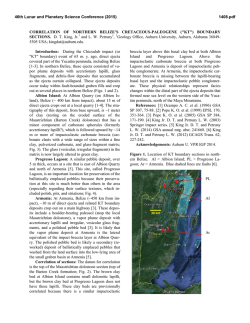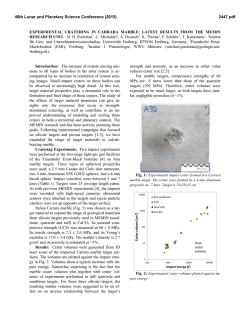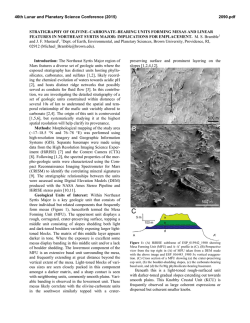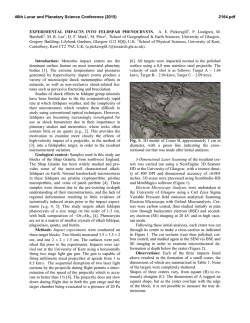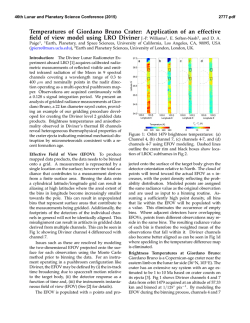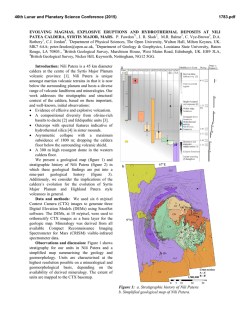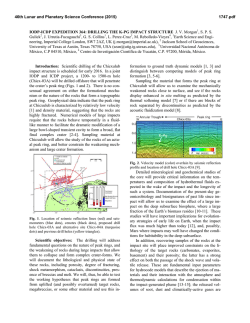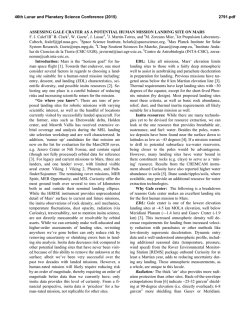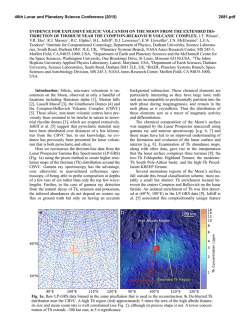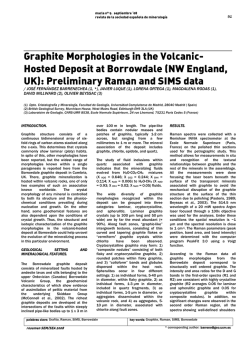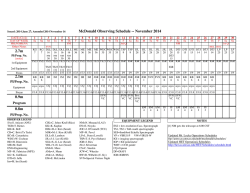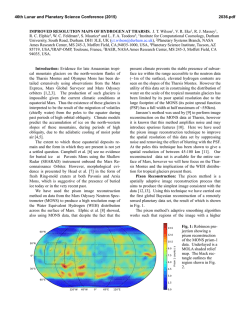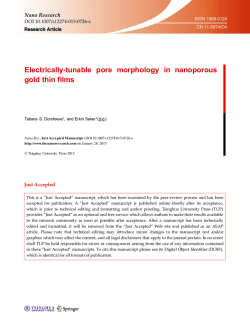
Layered Ejecta Morphologies on Syrtis Major and Implications for
46th Lunar and Planetary Science Conference (2015) 2645.pdf LAYERED EJECTA MORPHOLOGIES ON SYRTIS MAJOR AND IMPLICATIONS FOR REGIONAL GEOLOGY. R. D. Schwegman1, G. R. Osinski1,2, and L. L. Tornabene1. 1Centre for Planetary Science and Exploration/Department of Earth Sciences, University of Western Ontario, Canada, N6A 5B7, 2Department of Physics and Astronomy, University of Western Ontario, London, Ontario, Canada, N6A 5B7 ([email protected]). Introduction: Craters with layered ejecta (LE) morphologies occur globally on Mars and are considered to have resulted from the interaction of the ejecta blanket with some volatile component, likely water or ice, derived from the target [1, 2]. A considerable volatile component within basaltic rock would be difficult to attain as the permeability of these rocks are generally much less compared to that of sedimentary rocks [e.g., 3]; yet we still see layered ejecta morphologies on volcanic terrains on Mars. Here we focus on the Syrtis Major Planum to investigate the regional distribution and nature of layered ejecta morphologies. We propose that the LE morphology, particularly DLEs, results from craters excavating into a potentially volatile-rich target that was overlain by Syrtis lavas. Methods: Utilizing Robbins Crater Database [4], we have selected every crater 3–30 km in diameter on Syrtis Major (424 total) and reclassified them into 6 ejecta classes using THEMIS and CTX imagery: SLE, DLE, MLE, other LE, radial/no LE, and no ejecta visible. Craters displaying layered ejecta morphologies were classified as SLE, DLE, or MLE and are based on [5], while craters that were not discernable were placed in an “other LE” class. Craters with radial ejecta or other ejecta morphologies that were not LE were placed in a “no LE” class. The extent of the Syrtis Major Planum is defined using the geologic map of Mars [6, 7]. Craters on the edge of this boundary were included in our study. Excavation depths were estimated using [8] and [9]. Results: Table 1 summarizes the results from each class while Figure 1 shows the distribution. Craters with LE morphologies, collectively, account for ~36% of craters on Syrtis Major while the remaining ~64% of craters lack layered morphologies (including craters with no ejecta). Collectively, craters with layered ejecta morphologies are distributed evenly throughout Syrtis Major with no preferential alignment. An exception are craters displaying the DLE morphology, which occur predominantly in the eastern portion of Syrtis Major (Fig. 1). It should be noted that the “other LE” class may potentially include degraded DLEs that are presently unrecognizable. Crater size distributions also have no preferred alignment for layered ejecta craters. However, craters lacking layered morphologies (including those with no ejecta), on average, are ~4.4 km in diameter and account for ~64% of all craters on Syrtis Major. The distribution of craters in this group may favor the northwestern half of the Planum. SLE DLE MLE Other LE No LE No ejecta n 74 18 10 53 152 117 Avg. D 7.62 12.58 20.15 9.67 4.38 4.46 SD 2.57 4.55 4.43 4.87 1.43 2.13 Min. D 3.53 5.68 15.53 3.01 3.00 3.00 Max. D 15.33 23.77 29.24 23.8 10.95 15.98 Table 1: Average, minimum, and maximum diameters (D) for each class. Standard deviations (SD) given for averages. Diameters are measured in km. A B Fig. 1: Distribution of craters with LE morphologies (A) and those lacking LE morphologies (B). Smallest circles represent craters with diameters of 3 – 5 km, largest circles represent craters > ~20 km (i.e., mostly MLEs). Blue=SLE; Red=DLE; Green=MLE; Orange=other LE; Yellow=no LE; Black=no ejecta. Scale Bar 1000 km. 46th Lunar and Planetary Science Conference (2015) Discussion: Our results show that there are a number of layered ejecta morphologies within Syrtis Major. In addition, there are almost twice as many craters that do not display a layered ejecta morphology. These craters are, on average, ~4.4 km in diameter while those with layered ejecta morphologies are ~3 times the diameter (~12 km average). The simplest explanation for this difference is that a deeper excavation is required to access volatile-rich materials. Following on from this, it is, therefore, possible that those craters with layered ejecta morphologies are excavating through the Syrtis lavas to a volatile-rich layer beneath – and those lacking a LE morphology simply are not large enough to excavate that deep. This may be especially true for DLEs which are concentrated on the eastern side of Syrtis Major, where the Isdis ejecta is expected to be thicker. Esentially, the target material prior to the Isidis impact event is suggested to have been altered by aqueous processes, including fluvial activity, as evident by hydrated silicates around the rim of Isidis and found extensively in the Nili Fossae and Libya Montes regions [10–12]. This aqueous activity is believed to have persisted following ejecta emplacement, ceasing only prior to the onset of Syrtis lavas in the early Hesperian [10, 12–14]. This suggests that the ejecta blanket from the Isidis impact event was, and remains, volatile-rich. Hence, a two-layered general stratigraphy is suggested for the region with a relatively volatile-poor unit overlying a volatile-rich one. The thickness of Syrtis lavas have been estimated to be ~500 m to 1 km [14]. We assume that the lower limit of this range would correspond to the outer boundary of Syrtis and the upper limit to the center based on Syrtis Major being a low-relief volcanic shield [15]. We have estimated the depth of excavation and find that craters with observed diameters between 5 and 12 km excavate to depths corresponding with the estimated thickness range of the Syrtis lavas (0.5–1 km). This means that the smallest diameter at which a crater can excavate the full extent of the lower limit of Syrtis lavas is ~5 km. If we assume lavas are thickest near the center of the Planum, the minimum diameter at which a crater can excavate at least 1 km (upper limit of estimated lava thickness) is ~12 km. From our results, we have observed that the smallest crater diameter displaying a DLE morphology that also occurs near the center of Syrtis Major is also ~12 km. Lavas may also be thinner on the eastern side simply because of the uplift nature of impact crater rims from the surrounding terrain. This would allow for a shallower excavation depth to the underlying material and suggests all of the DLEs in Syrtis Major are excavating through the lavas. This two layered stratigraphy could explain the distribution of DLEs but it remains unclear why 2645.pdf there are SLE, MLE, and other LE morphologies in the same region. An explanation could be that all layered ejecta morphologies observed are excavating through the Syrtis lavas. Because there are smaller craters with an LE morphology (e.g., SLEs), the depth to an underlying volatile-rich layer would have to be shallower. This may suggest that the thicknesses of lavas might vary throughout all of Syrtis Major resulting from irregular topography due to the Isidis ejecta blanket and/or subsequent cratering in the Noachian. Topographic lows (e.g., craters) would presumably be infilled with lava and be thicker compared to lavas on topographic highs (e.g., crater rims/adjacent terrain). This would allow a smaller crater to have a LE morphology if it impacted where the lavas were thinnest (less depth to excavate to volatile-rich layer). An additional explanation may be that there is a volatile-rich layer(s) interbedded between lava flows. This would allow smaller craters to excavate down to a volatile-rich layer and result in a layered ejecta morphology. It has been suggested Syrtis Major was emplaced from two main eruptive stages [13, 15]. This implies a pause in activity at some point during the Hesperian and may allow for emplacement of a volatile-rich layer either by deposition (e.g., fluvial [10]) or alteration of the already emplaced lavas. This would be followed by burial and emplacement of later lava flows during the second stage of activity. An alternative may be that episodes of glacial or fluvial activity since emplacement of Syrtis Major have made the uppermost target volatile-rich (e.g., [10, 16]). References: [1] Carr M. H. et al. (1977) JGR, 82, 4055–4065. [2] Barlow N. G. and Perez C. B. (2003) JGR, 108, 5085. [3] Brace W. F. (1980) Int. J. Rock Mech. Min. Sci. & Geomech. Abstr., 17, 241–251. [4] Robbins S. J. and Hynek B. M. (2012) JGR, 117, E05004. [5] Barlow N. G. et al. (2000) JGR, 105, 26733–26738. [6] Scott D. H. and Tanaka K. L. (1986) USGS I-1802-A, 1:15M scale. [7] Greeley R. and Guest J. E. (1987) USGS I-1802-B, 1:15M scale. [8] Croft S. K. (1985) JGR, 90, C828–C842. [9] Melosh H. J. (1989) Impact Cratering: A Geologic Process, pp. 78. [10] Mustard J. F. et al. (2009) JGR, 114, E00D12. [11] Poulet F. et al. (2005) Nature, 438, 623– 627. [12] Tornabene L. L. et al. (2013) JGR: Planet., 118, 994–1012. [13] Ivanov M. A. and Head J. W. (2003) JGR, 108, 5063. [14] Hiesinger H. and Head J. W. (2004) JGR, 109, E01004. [15] Schaber G. G. (1982) JGR, 87, 9852–9866. [16] Head J. W. et al. (2005) Nature, 434, 346–351.
© Copyright 2025
